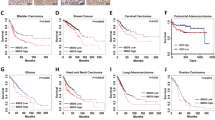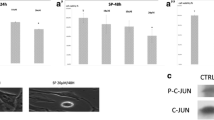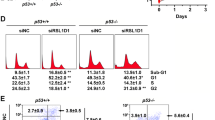Abstract
NOP53 ribosome biogenesis factor (NOP53) is a nucleolar protein involved in oncogenesis/tumor suppression, cell cycle regulation, and cell death. Here, we investigated the role of NOP53 in the maintenance of normal nuclear shape and chromosomal stability. Depletion of NOP53 by shRNA caused abnormal nuclear morphology, including large nucleus, irregular nucleus, and multinucleated cells, and chromosomal instability resulting in micronucleus or nuclear bud formation. The abnormal nuclear shape and chromosomal instability were restored by re-expression of NOP53. We further showed that NOP53 was involved in chromosome congression in metaphase. Downregulation of NOP53 induced aberrant chromosome congression and spindle checkpoint activation, resulting in delayed mitosis and mitotic arrest. Thus, our findings demonstrated that the nucleolar protein NOP53 participated in mitotic progression and that dysregulated NOP53 expression caused chromosomal instability in cancer cells.




Similar content being viewed by others
References
Boulon S, Westman BJ, Hutten S, Boisvert FM, Lamond AI (2010) The nucleolus under stress. Mol Cell 40:216–227
Amin MA, Matsunaga S, Uchiyama S, Fukui K (2008) Depletion of nucleophosmin leads to distortion of nucleolar and nuclear structures in HeLa cells. Biochem J 415:345–351
Amin MA, Matsunaga S, Ma N, Takata H, Yokoyama M, Uchiyama S, Fukui K (2007) Fibrillarin, a nucleolar protein, is required for normal nuclear morphology and cellular growth in HeLa cells. Biochem Biophys Res Commun 360:320–326
Kalt I, Levy A, Borodianskiy-Shteinberg T, Sarid R (2012) Nucleolar localization of GLTSCR2/PICT-1 is mediated by multiple unique nucleolar localization sequences. PLoS One 7:e30825
Kim JY, Seok KO, Kim YJ, Bae WK, Lee S, Park JH (2011) Involvement of GLTSCR2 in the DNA damage response. Am J Pathol 179:1257–1264
Lee S, Kim JY, Kim YJ, Seok KO, Kim JH, Chang YJ, Kang HY, Park JH (2012) Nucleolar protein GLTSCR2 stabilizes p53 in response to ribosomal stresses. Cell Death Differ 19:1613–1622
Yim JH, Kim YJ, Ko JH, Cho YE, Kim SM, Kim JY, Lee S, Park JH (2007) The putative tumor suppressor gene GLTSCR2 induces PTEN-modulated cell death. Cell Death Differ 14:1872–1879
Shibamoto Y, Streffer C, Fuhrmann C, Budach V (1991) Tumor radiosensitivity prediction by the cytokinesis-block micronucleus assay. Radiat Res 128:293–300
Kim JY, Cho YE, Park JH (2015) The nucleolar protein GLTSCR2 is an upstream negative regulator of the oncogenic nucleophosmin-MYC axis. Am J Pathol 185:2061–2068
Ugrinova I, Monier K, Ivaldi C, Thiry M, Storck S, Mongelard F, Bouvet P (2007) Inactivation of nucleolin leads to nucleolar disruption, cell cycle arrest and defects in centrosome duplication. BMC Mol Biol 8:66
Ma N, Matsunaga S, Takata H, Ono-Maniwa R, Uchiyama S, Fukui K (2007) Nucleolin functions in nucleolus formation and chromosome congression. J Cell Sci 120:2091–2105
Tsai RY, Pederson T (2014) Connecting the nucleolus to the cell cycle and human disease. FASEB J 28:3290–3296
Takada H, Kurisaki A (2015) Emerging roles of nucleolar and ribosomal proteins in cancer, development, and aging. Cell Mol Life Sci 72:4015–4025
Amin MA, Matsunaga S, Uchiyama S, Fukui K (2008) Nucleophosmin is required for chromosome congression, proper mitotic spindle formation, and kinetochore-microtubule attachment in HeLa cells. FEBS Lett 582:3839–3844
Maraldi NM, Lattanzi G, Capanni C, Columbaro M, Merlini L, Mattioli E, Sabatelli P, Squarzoni S, Manzoli FA (2006) Nuclear envelope proteins and chromatin arrangement: a pathogenic mechanism for laminopathies. Eur J Histochem 50:1–8
Vogt E, Kirsch-Volders M, Parry J, Eichenlaub-Ritter U (2008) Spindle formation, chromosome segregation and the spindle checkpoint in mammalian oocytes and susceptibility to meiotic error. Mutat Res 651:14–29
Acknowledgements
This study was supported by the Basic Science Research Program through the National Research Foundation of Korea (NRF) funded by MSIP (2011-0030072 and 2013R1A2A2A01009006) and the Ministry of Education (grant number NRF- 2016R1D1A1A09918014 to S Lee).
Author information
Authors and Affiliations
Corresponding author
Ethics declarations
Conflict of Interest
The authors declare that there is no conflict of interest.
Rights and permissions
About this article
Cite this article
Lee, S., Ahn, YM., Kim, JY. et al. Downregulation of NOP53 Ribosome Biogenesis Factor Leads to Abnormal Nuclear Division and Chromosomal Instability in Human Cervical Cancer Cells. Pathol. Oncol. Res. 26, 453–459 (2020). https://doi.org/10.1007/s12253-018-0531-4
Received:
Accepted:
Published:
Issue Date:
DOI: https://doi.org/10.1007/s12253-018-0531-4




